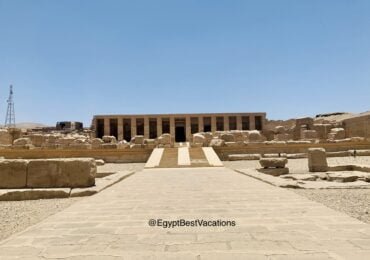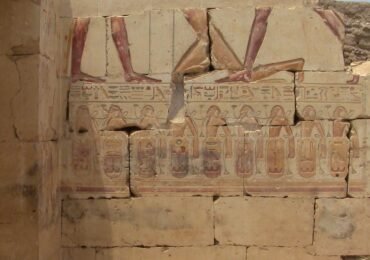Best Things to Do in Abydos
Abydos, Egyptian Abdju, Coptic Ebot, modern Al-ʿArābā al-Madfūnah, prominent sacred city and one of the most important archaeological sites of ancient Egypt. The site, located in the low desert west of the Nile River near Al-Balyanā. It was a necropolis for the earliest Egyptian royalty and later a pilgrimage center for the worship of Osiris.
About 11 km (6 miles) west of the Nile River and 300 miles south of Cairo and about 50 km from Sohag. The ancient site is a mosaic of styles and customs. Representing the political, social, and religious evolution of the long-lasting and unique Egyptian Empire. Although the site was looted for centuries before archaeologists like William Matthew Flinders Petrie and Auguste Mariette could establish standards of research. Abydos has provided significant information regarding the history of Egypt. In particular, the “Table of Abydos” lists all the pharaohs, a unique validation of knowledge of this time period. Sites such as Abydos, illuminating the nature of this outstanding civilization. It provides valuable insights into human history and consequently support the advance of human society.
List of Things to do in Abydos:
Here’s a guide to the top things to do in Abydos:
The Temple of Seti I:
Seti I is one of the lesser-known pharaohs of the New Kingdom period of ancient Egypt. However, his temple in Abydos is among the most famous. Cited by many as the most impressive religious structure still standing in Egypt.
Seti I’s place in history was overshadowed by that of his son, Ramesses II, arguably one of the greatest pharaohs in Egyptian history. Yet, Seti was an important character in his own right. He was one of the pharaohs who had to bring order back to Egypt and re-establish Egyptian sovereignty over its eastern neighbors (Syria and the Levant) following the social disruption caused of Akhenaten’s religious reforms . Seti was also responsible for commissioning the construction of a grand temple in Abydos. Often referred to as the Temple of Seti I or the Great Temple of Abydos.

The first structure you’ll see at Abydos is the Great Temple of Seti I. After a certain amount of restoration work, is one of the most complete, unique and beautiful temples in Egypt. With exquisite decoration and plenty of atmosphere. It is the main attraction here, although the nearby Osireion is also wrapped in mystery and the desert views are spectacular.
This great limestone structure, unusually L-shaped rather than rectangular. It has seven great doorways and was dedicated to the six major gods – Osiris, Isis, Horus, Amun-Ra, Ra-Horakhty and Ptah – and also to Seti I (1294–1279 BC) himself. Less than 50 years after the end of the Amarna ‘heresy’ – when Pharaoh Akhenaten broke with tradition by creating a new religion, capital and artistic style – this is a clear attempt to revive the old ways. As you roam through Seti’s dark halls and sanctuaries, an air of mystery surrounds you.
Temple of Ramses II:
Ramesses at Abydos, after construction on his father’s, Seti I, temple was completed in the 19th Dynasty built nearby his father’s temple. Ramesses II Temple is made of beautiful pink and black granite with painted limestone walls. The temple is dedicated primarily to Osiris, along with Sety I as the earthy form of Osiris, Isis, and Horus. The site, mainly in ruins, was first excavated by W.J. Bankes who found a kings list in the temple. Further excavations were done by Auguste Mariette who excavated the site in 1869 and completed the site report in 1880. Flinders Petrie continued excavations on the site in 1902-1903 referring to the temple as “The Portal of Ramesses II.” The most detailed report of the site to this day was done by David O’Connor in 1967. Where a full, correct floor plan was made, along with detailed descriptions of the walls images and text. Presently, most projects at the site are working on conservation of the sites decrepit ruins.

The Osiron:
Southwest of the Temple of Seti I, you find the large structure known as the Osireion. Often taken for the Tomb of Osiris. It is, in reality, a cenotaph of Seti I, closely associated with the main temple. It was discovered in 1903 by Margaret A. Murray and excavated between 1911 and 1926 by the Egypt Exploration Society under the direction of E Naville and Dr. Frankfort.

The building, originally covered by an artificial mound and surrounded by trees, was erected by Seti I, but remained unfinished. Later, some rooms were decorated with religious scenes and inscriptions by Merneptah. The main structure is built of white limestone and reddish sandstone. Red granite being used only for the pillars and roof of the main hall and some of the doorways.
It’s unfortunately closed to the public. Head to the back of the Temple of Seti I to get a decent overall view of the building.
Shunet Al-Zabib:
One of the great things to do in Abydos is visiting Shunet Al-Zabib. Shunet el-Zebib was built circa 2750 B.C. and served as a funerary cult enclosure of the Khasekhemwy, a second dynasty king. The structure is one of Egypt’s oldest standing royal monuments and one of the oldest preserved mud brick buildings in the world. The two-part funerary complex, consisting of the underground tomb and the above-ground enclosure, is of great architectural importance, as it portrays the earliest stages of the evolution of the pyramid. The structure includes two concentric rectangular enclosure walls. Most of the inner wall is intact while only part of the outer wall remains.. The enclosure walls stand 11-12 meters high in some places but suffers from structural instabilities as a result of a rising water table due to agricultural development, animal intervention, and wind and rain erosion.

Shunet el-Zebib is the only surviving standing structure of a series of funerary complexes built in the area between 3000 and 2750 B.C. by the kings of the first and second dynasties, and is therefore the only example of this earliest tradition of royal monumental funerary construction that still exists. The structure is also important in the evolution of the pyramid. Djoser, Khasekhemwy’s successor, built the Saqqara Step Pyramid, the earliest pyramid, the design of which is influenced by tomb and enclosure structures such as Shunet el-Zebib.
Umm El Qa’ab:
Umm el-Qa’ab was used as a burial ground serving the elite ruling the area of Abydos since early Predynastic times, from at least the Naqada I period, ca. 3800 BC. It was the royal cemetery during the 1st Dynasty and was also used by the two last kings of the 2nd Dynasty, confirming Manetho’s statement that the early kings of Egypt originated from This, near Abydos.
The area has been divided into two cemeteries, U and B. Cemetery U is dated to the Predynastic era and includes the famous tomb U-j, which belonged to a powerful ruler whose influence may perhaps have extended as far as Lower-Egypt. This tomb has yielded some inscribed tablets, which are believed to be the oldest known examples of writing to humanity. One of the tables may have contained an early writing of the name of Bubastis, a city located in the western Delta. If this writing is correct, then the owner of tomb U-j must at least have had trading contacts with Lower-Egypt.
Cemetery B is dated to the Early Dynastic Period, and was exclusively used by the royal family. The tombs are significantly larger than those in cemetery U. The increasing size of the tombs hints at the increasing wealth and power of the ruling family and at the better mastery of crafts.
Tomb of Djer:
Even though each royal tomb is different from the other, they all share the same basic structure, which consists of a large, square pit dug into the ground, lined with mudbrick walls. This pit was used as the main burial room. It was often surrounded by additional chambers, at a slightly higher level than the burial room itself. In the tombs of Djer and Djet, these rooms open off the central chamber. From the tomb of Meretneith onwards, they would surround the burial chamber, without interconnecting.
From the reign of Djet onwards, the superstructure of the tombs appears to have consisted of a hidden mound over the main burial chamber and a larger mound covering the entire tomb. There are indications that the large mound may also have hidden the subsidiary tombs which, starting from the reign of Aha, extended from or surrounded most 1st Dynasty royal tombs. If this is indeed the case, then it is clear that the subsidiary burials all occurred at the same time as the royal burial.
Where to stay in Abydos?
When planning your trip to Abydos, selecting the right accommodation is essential to ensure a comfortable and enjoyable stay. While Abydos may not have the same extensive range of lodging options as larger Egyptian cities, Cairo and Luxor. There are still several excellent choices that cater to different preferences and budgets. Here are some recommended places to stay in Abydos:
House of Life Hotel Abydos:
Located just a short walk from the Temple of Seti I, House of Life Abydos offers a unique blend of comfort and historical charm. The hotel features traditional Egyptian architecture, well-appointed rooms, and an inviting swimming pool.
Amenities: Restaurant, swimming pool, free Wi-Fi, guided tours, wellness center.
Ideal for: Travelers seeking a comfortable stay with convenient access to historical sites.
Abydos Guesthouse:
This cozy guesthouse provides a homely atmosphere with personalized service. The rooms are simple yet comfortable, and the hosts are known for their hospitality and local knowledge.
Amenities: Complimentary breakfast, free Wi-Fi.
Ideal for: Budget travelers and those looking for a more intimate and authentic experience.
Tips for Booking Accommodation in Abydos:
- Advance Booking: Abydos is a popular destination for history enthusiasts, so it’s advisable to book your accommodation in advance, especially during peak tourist seasons.
- Local Recommendations: Consider reaching out to local tour operators or guides for recommendations on the best places to stay based on your interests and itinerary.
- Check Amenities: Ensure your chosen accommodation provides the amenities you need for a comfortable stay, such as air conditioning, Wi-Fi, and transportation services.
Abydos Tours:
Egypt Best Vacations offers a wide range of tours to Abydos from Luxor and other destinations in Egypt. You might be interested in one of these tours:
Full Day Tour To Dendera Temple And Abydos Temple From Luxor
Tour To Dendera & Abydos From Port Safaga
2-Day Luxor, Dendera And Abydos Tour From Port Safaga
Abydos is a destination that promises to enchant history buffs, culture enthusiasts, and adventure seekers alike. Plan your visit to this extraordinary city and uncover the timeless allure of ancient Egypt. Whether you prefer a luxurious hotel, or a cozy guesthouse. Abydos offers a variety of accommodation options to suit your needs. Enjoy your stay and the incredible history that awaits you in this ancient city!

